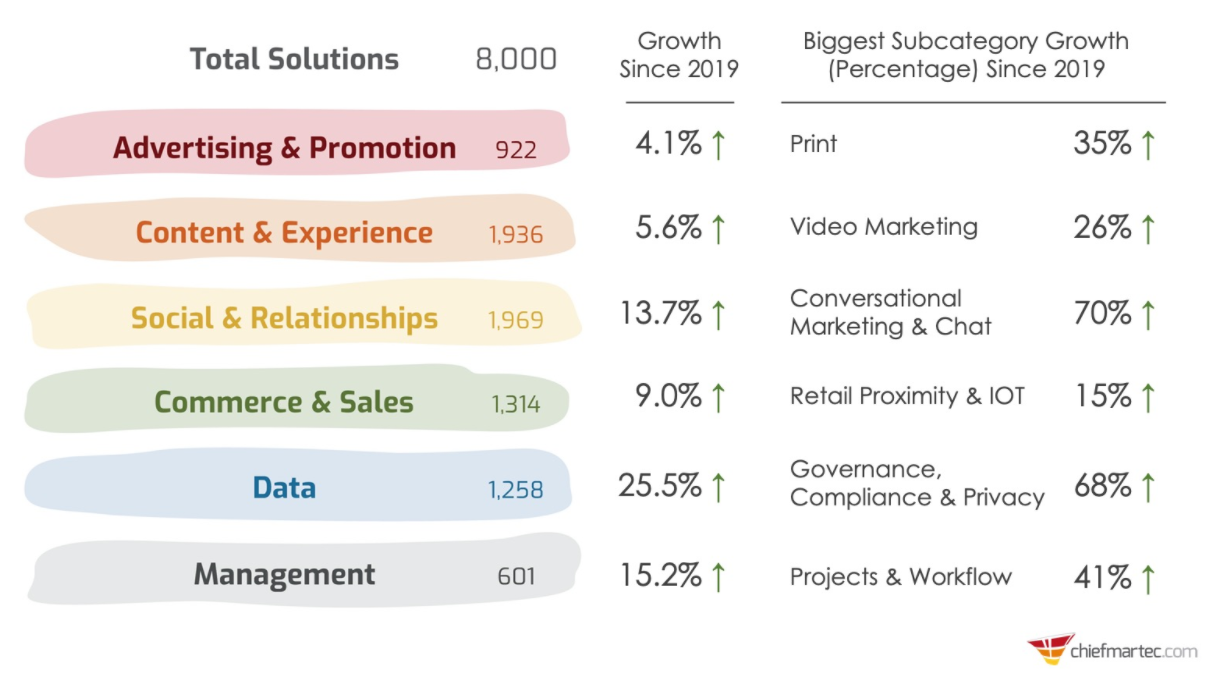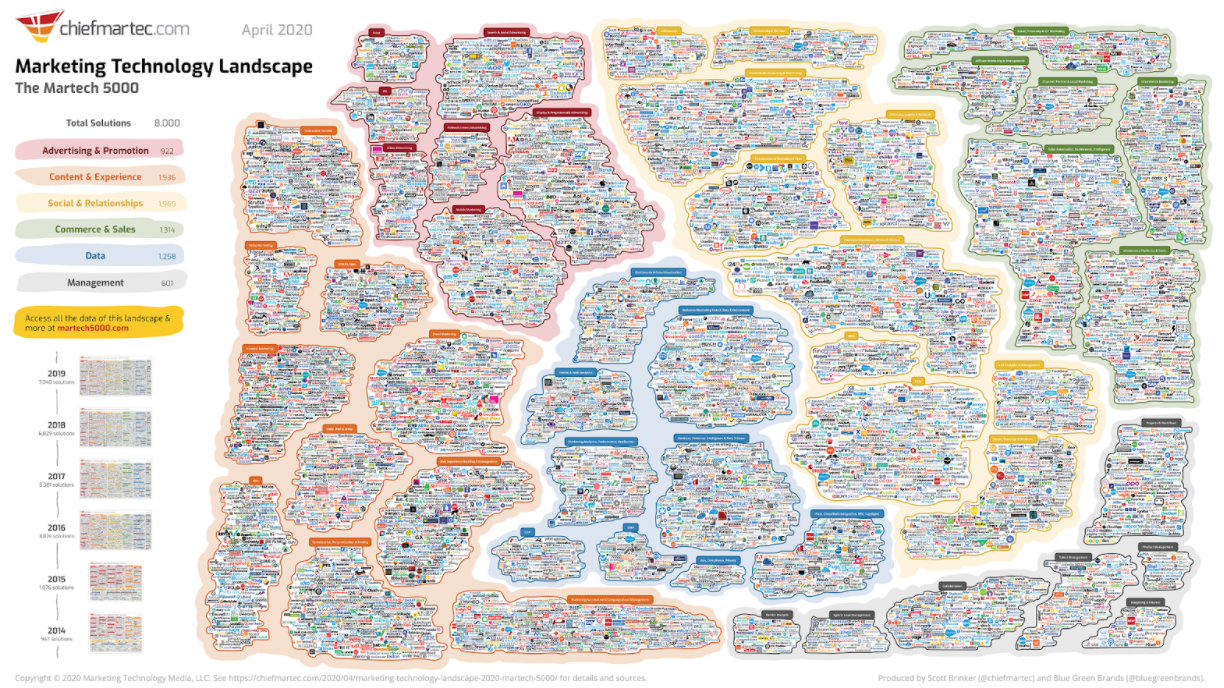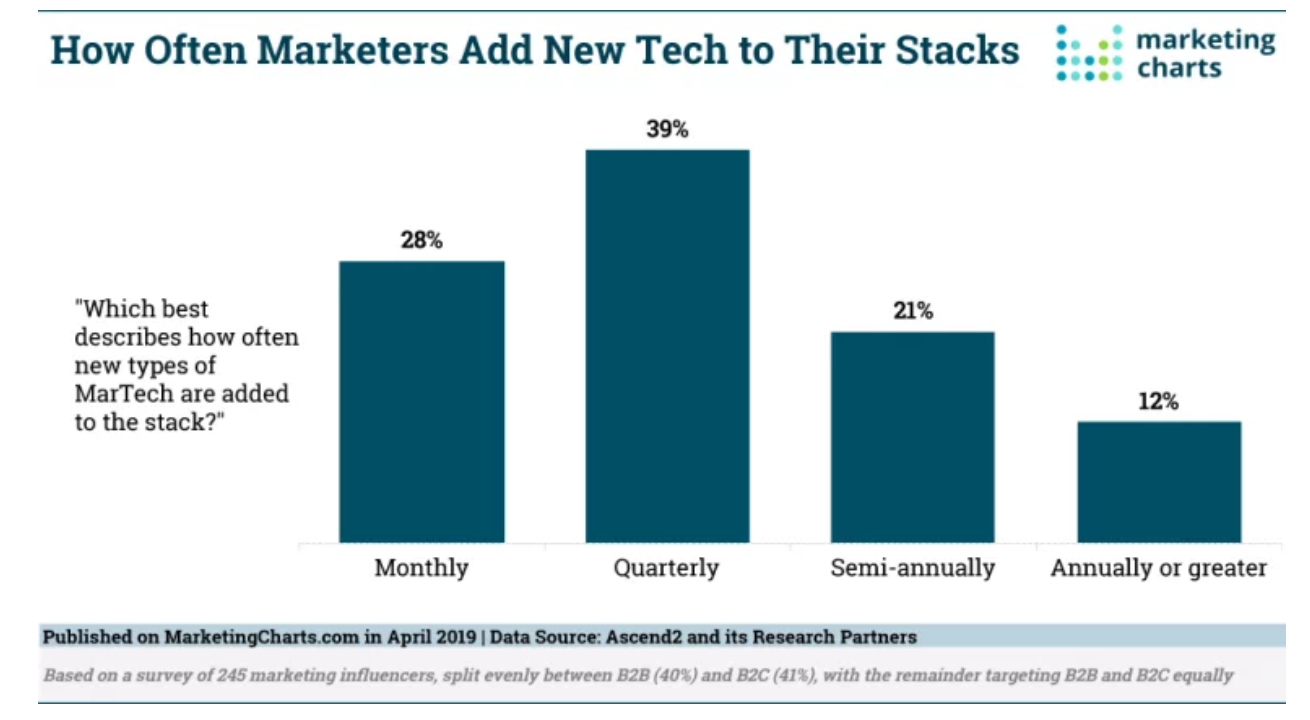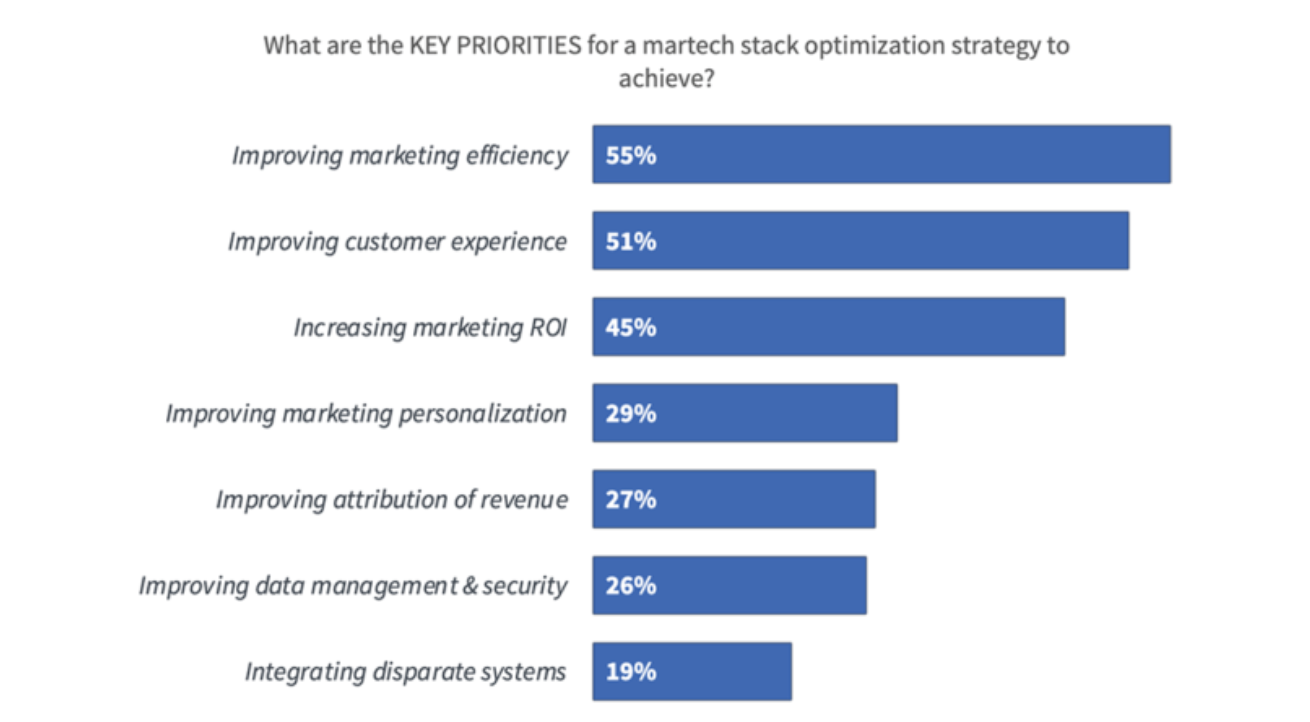Marketing Tech Stack Strategy
Your marketing tech stack, or MarTech for short, is your virtual toolbox for your digital marketing needs. With over 8,000 MarTech “tools” available, the perfect ones for your marketing needs are out there. You just have to find them, and that starts with having a solid marketing tech stack strategy.
It’s important to analyze your marketing technology tools individually and as part of your larger technology stack. Ensure that each tool seamlessly integrates with the others. This will help with automation and ease of use. Both of which increase the utilization of the tools, thereby increasing efficiency.
Whether you are looking to update your marketing stack or create a new one, this article has everything you’ll want to know about the current marketing tech landscape and the best marketing tech stack strategy.
- What is a Marketing Technology Stack?
- 2021 Marketing Tech Trends
- Building A Marketing Tech Stack
- Updating Your Existing Tech Stack
- Toolbox For An Effective Tech Stack
- Measuring The Effectiveness Of Your Tech Stack
- How It All Stacks Up
What is a Marketing Technology Stack?
All marketers incorporate some type of technology in their work, but for digital marketers, technology is foundational.
Marketing technology is any software you use for digital marketing purposes. Your MarTech stack is the collection of all of the marketing technology software you use for marketing.
A good marketing tech stack strategy is:
- Fully integrated
- Automated
- Data-driven
- Personalized
- Minimal
Marketing technology is used at every level of digital marketing from customer experience to analytics. With MarTech, marketers can gather and manage data and experiment with various marketing strategies to find the best combination of software and tools.
Your marketing tech stack can help bring more traffic to your site, increase conversions, and improve customer retention rates. All of this will improve your return-of-investment, or ROI.
Types of MarTech
There are MarTech solutions for just about any digital marketing need you could imagine. You can use your stack for social media marketing, group management and collaboration, email automation, and customer data analysis.
The Marketing Technology Landscape, created by Scott Brinker at chiefmartec.com, sorts MarTech tools into six categories. Those categories are further broken into sub-categories for a total of 49 groupings. An effective tech stack draws from all six categories and 49 subcategories.
Some solutions span multiple categories. For example, HubSpot is a CRM (customer relationship management) and CMS (content management system) platform. With Hubspot, you can manage your SEO strategies, edit your website, automate scheduling, analyze your marketing data, and more all in one place.
Other marketing technology solutions are more focused on one or two services. For example, SpyFu offers analytics for SEO and pay-per-click (PPC) advertising which falls under the Content & Experience category. The French advertising company, Criterio, falls under the Advertising & Promotion category. Check out this list of the top MarTech tools of 2020 to familiarize yourself with more quality digital marketing solutions.
2021 Marketing Tech Trends
Fully understanding what MarTech is and how to use it effectively includes understanding the current marketing technology landscape. The MarTech industry, like all tech industries, is rapidly growing and evolving.
Martech options have grown exponentially in the last few years. There were about 2,000 MarTech solutions in 2015, and now there are over 8,000. More options also mean companies and marketers may struggle to find the perfect combination for their technology stack. This makes the development of stack strategy even more important than it used to be. You don’t want to hastily throw together a bunch of technology. It’s not financially productive.
The growth in marketing technology solutions, however, does not mean marketers’ tech stacks are getting larger. Actually, trends are heading in the opposite direction. Instead of offering new, exciting solutions, companies are focusing on streamlining what they already have.
Many companies are on a tighter budget due to the economic effects of the COVID-19 pandemic. However, they are also adapting their marketing strategies to meet the changing needs and behaviors of customers in unprecedented ways. To do this, marketers are spending more of their budgets on their tech stacks than ever before. The average CMO spends about one-third of their budget on MarTech. In other words, there is no better time than now to become a marketing tech expert.
Personalization is one of the key factors in a great marketing tech stack, but it’s not necessarily a new trend. A report on the trends of marketing spending by Gartner in 2018 found that “CMOs spend an average of 14.2% of their budget on personalization efforts”. Since then, that focus on personalization has only increased and is predicted to continue to do so. Research shows that 80% of consumers want personalization from companies they are doing business with. Consider personalization a primary factor to look for in all of your marketing technology tools.
Building a Marketing Tech Stack
When a new company or product is created, a new marketing tech stack strategy needs to be created to initiate and manage effective digital marketing strategies. To help you build a new technology stack, we have a simple formula to follow.
Define Your Desired Outcomes
The first step to an excellent technology stack is clear marketing goals. Whether you are building a new marketing stack from scratch or improving an existing one, clarifying your outcomes is key.
A goal may be to improve your ROI by securing more quality leads and conversions. While it’s easy to focus on exciting, innovative technology, effective tech stack builders focus on their goals.
When articulating your desired outcomes, think about your product and your audience. The tools you choose to add to your stack should fit your specific needs and reach your specific audience. Think about how you are going to reach your audience and then look for tools that match that strategy.
Choose the Right Tools
Simplicity is ideal in a marketing technology stack, so only choose those that you need. We all love cool, new tech, but resist the urge to grab it and add it to your toolbox without necessity.
So, where do you start in the sea of over 8,000 MarTech solutions? Shop around and do your research. The 2018 Marketing Technology Survey by Gartner found that the average marketer references five different sources before deciding to purchase a new tool.
The exact amount of tools you need in your tech toolbox varies. You will want to ensure that you cover all your technology needs to reach your desired growth outcomes. Refer to Brinker’s MarTech categories and the current industry trends detailed above to guide you.
Companies that offer solutions and tools that span multiple MarTech categories may be an excellent addition to your stack. Having fewer tools while still covering all the categories can increase ease of use for your staff and clients. There is more consistency and familiarity which will increase the utilization of the software tools.
While this consolidated approach is not the universal solution, it is worth exploring when shopping for new marketing technology.
Manage Your Stack
Underutilization of the marketing tech stack is cited as a common problem for marketers. The 2020 Gartner marketing tech study found that marketers only utilize 58% of their stack’s capabilities. That’s why creating an actionable plan for consistently managing your tech stack is a foundational step. It shouldn’t be an afterthought.
According to the Gartner report, there are three main reasons why underutilization occurs:
- A lack of collaboration between different tools and categories
- Too many marketing tech solutions in your stack
- A lack of quality customer data

Segment is the top-rated customer data management platform (CDP) and a great addition to any stack. It has built-in features to increase utilization including personalization, integration with other tech, and easily digestible data on each of your customers.
It’s also important for customer data to focus on the customer’s entire journey to buying a product or service which could span several weeks and multiple channels.
After your data tools are set up, try to use the other tools you already have to solve problems as they arise. Instead of immediately looking for a new tool to add to your stack, see where you can utilize the same tools for multiple functions. Think of it as expanding your marketing stack horizontally rather than vertically.
Updating Your Existing Tech Stack
If you already have a marketing tech stack in operation, we recommend updating it multiple times a year. From 2019 to 2020 the number of marketing tech solutions increased from 7,040 to 8,000. Even if there isn’t anything specific you need to fix, there is likely new tech out there that may fit your company’s or client’s needs better.
A study of 245 marketing influencers found that the majority of marketers have updated their tech stacks four times a year or more.
An effective stack isn’t set in stone. It’s consistently evaluated for shortcomings and gaps that can be addressed to increase efficiency. This regular auditing process should be data-driven and built into your MarTech strategy.
Regularly updating your MarTech stack will improve the efficiency of your marketing campaigns. Easy to follow steps are listed below:
- Ground Yourself With Goals: Solidify your goals first just as you would with a brand new stack or any new marketing campaign. Your desired outcomes may shift over time and as market trends change.
- Conduct an Audit: Audit and evaluate the MarTech you already have. Identify areas where you aren’t utilizing it to its full potential.
- Purge Your Stack: This will also reveal any technologies that you don’t need anymore. Perhaps you upgraded to a new technology that overlaps with another tool you already have. This overlap is wasted money, so it should be eliminated when possible.
Toolbox For An Effective Tech Stack
Now that we have a shared understanding of technology stacks and the current marketing tech landscape, let’s put everything together. We consolidated all the strategic advice in the post down to five main tips. This quick reference list can be used anytime you are building a new tech stack or updating an existing one.
- Always start with your growth goals clearly defined.
- Your tools need to be chosen mindfully and updated regularly.
- A complete marketing tech stack includes solutions for advertisement, content & customer experiences, social media & relationships, sales, data, and management.
- Keep a keen eye out for any underutilization and overlap of tech tools in your stack.
- Focus on personalization, automation, data, and integration when choosing and utilizing digital marketing tech tools.
Through these strategies, you will maximize the power of your tech stack.
Measuring The Effectiveness Of Your Tech Stack
According to a survey conducted by Ascend, the number one priority for marketers is improving their marketing efficiency. This isn’t surprising considering how much money can be saved from cutting out the unnecessary parts of a marketing campaign. The second-highest priority, not far behind, is improving customer experience which is congruent with the current MarTech trends.
Data is your friend when evaluating the effectiveness of your marketing tech stack. Look for changes in your customer acquisition costs, conversion rates, and customer retention. Positive changes in these categories signal improved marketing efficiency and/or customer experiences.
Make sure to track all changes made to your marketing tech stack and strategies in order to accurately measure their efficacy. This allows for more increasingly targeted changes as your marketing campaigns become even more effective.
If you found that you’re not reaching your desired conversion rates with your current strategies, Augurian has a conversion rate optimization test that can provide insights into the best next steps.
How It All Stacks Up
Marketing technology can be your best friend or your worst enemy depending on how it’s used. Don’t let yourself get crushed under the weight of too many extraneous tools. Keep it simple. And as we have shown, focusing on the key elements of personalization, automation, data, and integration can ensure that you see the most significant results from your marketing campaigns.
The MarTech industry continues to grow every year and isn’t projected to stop anytime soon. A powerful marketing tech stack strategy has become a fundamental element of any digital marketing campaign no matter how big or small.
If you are looking to build or update your marketing technology stack, we can help! At Augurian, we do the work of wading through all the available tools to find the perfect ones and help you utilize them to their maximum efficiency.








